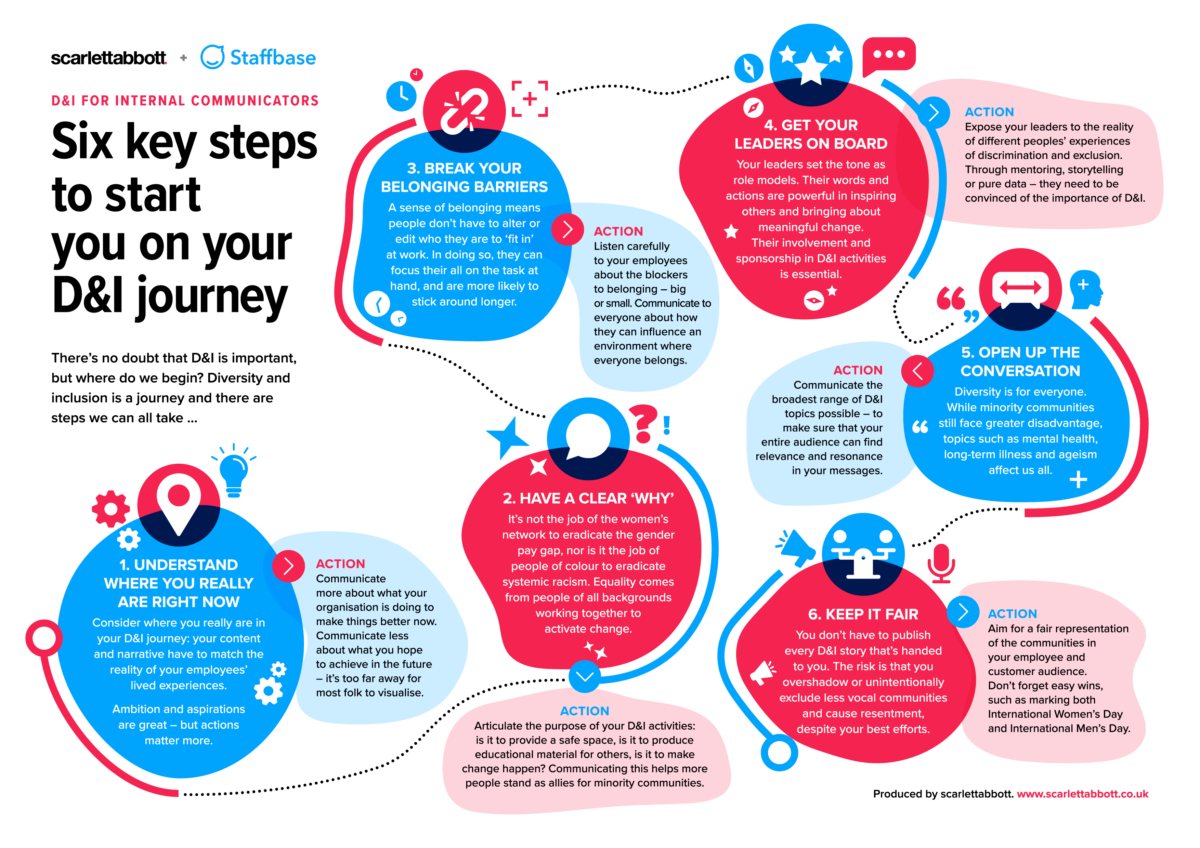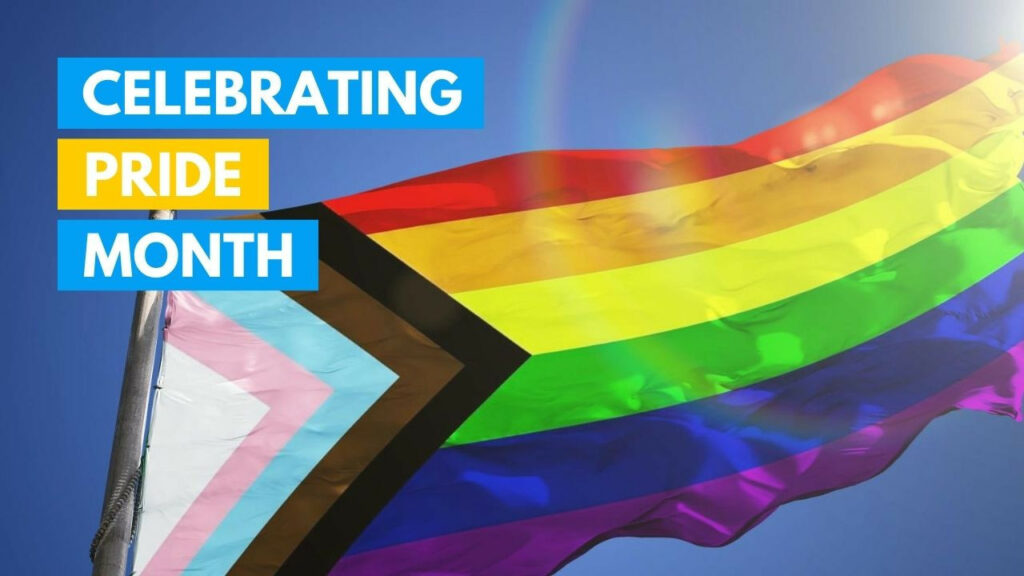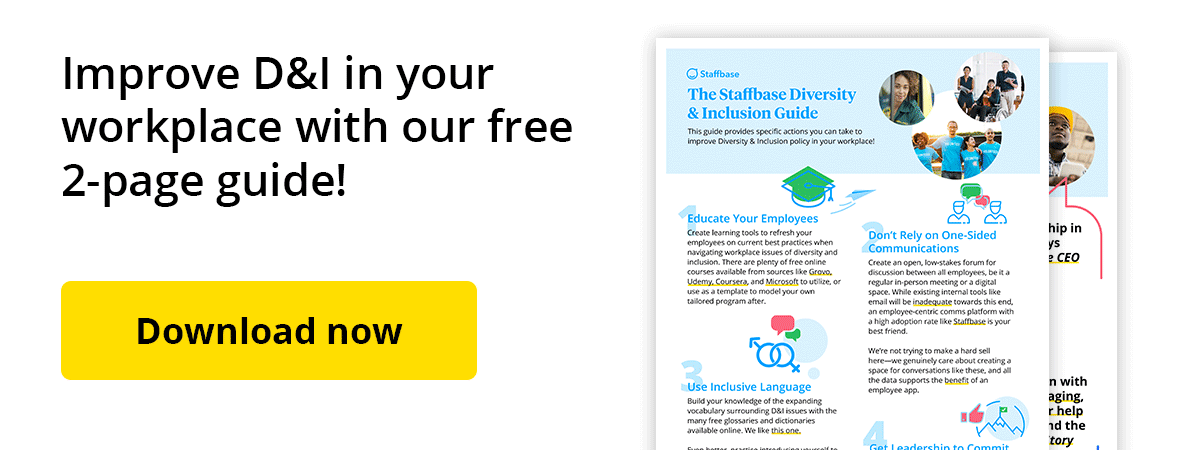6 Ways Internal Communications Can Promote Diversity, Equity, and Inclusion at Work
Fostering true diversity, equity, and inclusion in the workplace requires an engaged conversation among everyone in your organization. That's where internal communication enters the picture.

As a white, middle-aged, American man, I’m torn between doubting whether I’m the ideal person to be writing about diversity, equity, and inclusion at work and thinking that I’m exactly the sort of guy who needs to be pondering this stuff. Like most people I know, I consider myself a tolerant, fair-minded human. But I also know that I have plenty of biases of which I may not even be aware.
Bearing this in mind, I’ve been trying to better understand systemic inequality, at work and in the world at large, investigating as much as I can and talking with people of many different ages and backgrounds. I’m committed to becoming an ally, using my privilege and position, such as it is, to drive change in business. And I’m especially interested in how internal communicators can lead the way. This article isn’t close to having all the answers, but I hope it’s a start. That’s what writing it has been for me.
Americans spend one-third of their lives at work, making it the perfect place to cultivate an environment of diversity, equity, and inclusion. If such a world could exist in the workplace, then it stands to reason that the world outside of work would also be transformed. It’s a big ask, but let’s take a look at how we might get started.
What’s the meaning of diversity, equity, and inclusion at work?
DE&I stands for diversity, equity, and inclusion, three qualities often thought to be one and the same. But they’re not. In the workplace, diversity shows itself pretty clearly through representation. But without equity and inclusion — the crucial connections that attract and retain diverse talent— encouraging engagement, fostering innovation, and generating business growth simply can’t happen.
Diversity is the condition of having or being composed of differing elements, especially the inclusion of people of different races, cultures, sexes, etc., in a group or organization.
Equity means fairness or justice in the way individuals are treated.
Inclusion is the act or practice of including and accommodating people who have historically been excluded (because of race, gender, sexuality, or ability), ensuring that they feel a sense of belonging.
Diversity is being invited to the party. Inclusion is being asked to dance.”
Vernā Myers, HR expert and diversity advocate
The bottom-line benefits of DE&I: integrating diversity and inclusion at work
Why does promoting diversity and inclusion activities at work matter? Why should DE&I be a priority? Here’s an easy answer …
Ethnically diverse companies perform 33% better than the norm
Since 2016, Forbes’s list of America’s Best Employers for Diversity has reported an approximate average of 20% higher revenue growth than non-diverse companies. McKinsey reports that corporations that identified as being more diverse and inclusive were 35% more likely to outperform their competitors. A different study by them found that companies with a racially diverse board of directors report 43% higher profits. Meanwhile, companies with a more gender-diverse C-suite are 21% more likely to have above-average profitability.
Gartner, the technology research and consulting company, has also found that “organizations that enact sustainable DE&I strategies achieve up to a 20% increase in organizational inclusion.”
People clearly want to work in diverse workplaces
67% of job seekers say that they look for racial and gender diversity in prospective workplaces. And 50% of current employees want their organizations to put more effort toward promoting diversity. Those numbers only increase when talking to younger workforce members. 34% of millennials and 38% of Gen Z employees believe systemic racism is widespread in the workplace. They are also the people most likely to call out racism and sexism, and to shun companies and employers whose actions conflict with their personal values.
Corporate America appears to be catching on to both the economic and societal benefits of increased diversity and inclusion. But a majority of businesses still lag behind. In 2021, there were only four Black CEOs in the Fortune 500, and by February 2024, the number only rose to 8. (Which is just 1.6% of the total CEOs.)
The gender pay gap in the US stands at a female-to-male earnings ratio of 81.9%. According to the Economic Policy Institute’s State of Working America Wages 2019, Black workers with advanced degrees earned only 82.4% of the wages earned by white workers with advanced degrees. And while 5.1% of US women and 3.9% of US men identify as LGBTQIA+, their representation in corporate America is considerably less. So let’s see if these numbers have improved …
As of 2024, this ratio has only seen a slight improvement. Women now earn 84 cents for every dollar earned by men working full-time, and 78 cents when part-time workers are included. This indicates a modest increase. Meanwhile, the pay gap for Black women, Native American women, and Hispanic women has narrowed only slightly. It’s clear that significant challenges continue to persist.
What does DE&I mean for your customers?
The reason these and countless other issues persist is that the business case for integrating diversity, equity, and inclusion programs doesn’t really speak to any specific problem. It’s therefore reasonable to think that the only way businesses will get real about tackling the issue of diversity, equity, and inclusion at work is to be convinced of the bottom-line impact.
That brings us to the matter of customers, something most businesses need. The US population as of the 2023 census is 50.4% female, 19.1% Hispanic, 13% Black, and 6% LGBTQIA+. It therefore stands to reason that your customer base looks similar. Assuming that’s the case, doesn’t it make sense for your workforce to mirror these numbers?
But even then, the job of achieving true diversity is hardly finished. The threshold number at which minority groups feel truly represented is 30%. That’s a big number, but consider it one more reason to start integrating diversity, equity, and inclusion activities ASAP.
Where does diversity, equity, and inclusion at work begin?
One of the biggest challenges of initiating diversity, equity, and inclusion at work is knowing where to begin. Diversity hiring policies will help identify and reduce biases related to a candidate’s age, race, gender, religion, sexual orientation, or other personal characteristics unrelated to job performance and qualifications.
But diversity for diversity’s sake means very little. Equity and inclusion, on the other hand, are what make a real impact in the workplace. Companies can mandate diversity, but they have to cultivate equity and inclusion. Without those two elements, diversity amounts to no more than tokenism.
So, let’s begin.

1. Understand where you really are right now
Consider where your company stands in its DE&I journey. Ambition and aspirations are great — but real action is what leads to real results. Just as your workforce representation should strive to mirror that of the world at large, your content and narrative need to match the reality of your employees’ lived experiences.
Action: Communicate more about what your organization is doing to make things better now. Talk less about what you hope to achieve in the future — it’s too far away for most people to visualize.
For example, at Staffbase, we use an employee app to communicate our Global Policy for Diversity, Equity, and Inclusion — and Against Discrimination and Harassment, and we use the app’s “acknowledgement function” to make sure employees read it.
2. Have a clear “why”
Equality in the workplace is everyone’s business. It comes from people of all backgrounds working together to activate change.
We can’t stress it enough: you need to move beyond diversity to equity and inclusion. As written above, organizations that focus on the value of equity and inclusion, in addition to diversity, typically enjoy superior performance as compared with peer organizations that do not. But it takes a solid strategy. Here are 5 Ways to Launch a Diversity and Inclusion Communication Strategy at Work.
Equity in the workplace recognizes that it’s our differences that make people unique. Equity-centric businesses consider individual needs and develop new structures that take into account the disadvantages faced by minority groups.
Inclusion is when all of your employees feel like they belong and have the opportunity to voice their opinions. Subsequently, they don’t feel excluded on the basis of their identity, and they see themselves reflected in your company’s values.
Action: Articulate the purpose of your diversity, equity, and inclusion activities at work: Is it to provide a safe space at work? Is it to produce educational material? Is it to create change? Communicating your goals helps more people stand as allies for minority or underrepresented communities.
Again using our own example, Staffbase actively encourages employees to bring their whole selves to work, and invites them to share their voices. During Pride month we asked an array of employees the question, “What does Pride mean to you?” We then shared the responses with the entire company in our employee app. For Pride 2024, we even encouraged the sharing of furry friends in Pride attire.
 Get all of your employees involved in your DE&I efforts.
Get all of your employees involved in your DE&I efforts.
3. Break your belonging barriers
A sense of belonging means people don’t have to edit who they are to fit in at work. In doing so, they can focus their all on the task at hand and are more likely to stick around longer.
Action: Listen carefully to your employees about the blockers to belonging — big or small. Communicate to everyone about how they can influence an environment where everyone belongs.
Staffbase has questioned in the past whether it was the equal and diverse workplace it wanted to be. We paired with CultureWizard to roll out internal DE&I training for the whole company and made taking it mandatory for employees worldwide. (And for what it’s worth, that’s how I found out about some of my hidden biases, which was eye-opening.)
When we listen and celebrate what is both common and different, we become a wiser, more inclusive, and better organization.”
Pat Wadors, HR and People Experience leader
4. Get your leaders on board
Your leaders set the tone as role models. Their words and actions are powerful in inspiring others and bringing about meaningful change. Their involvement and sponsorship in DE&I activities is essential. Companies that have above-average leadership diversity generate 19% higher innovation revenues than those with below-average diversity.
Prioritize inclusive leadership when thinking about how to promote diversity and inclusion at work. Leaders who demonstrate behaviors such as courage, curiosity, and cultural intelligence tend to enable cultures that encourage inclusiveness.
Treat the evolution of diversity and inclusion activities as business-critical, not compliance-necessary. Organizations that approach diversity and inclusion as a business priority are more likely to report the kinds of superior business outcomes highlighted above.
Action: Expose your leaders to the reality of different peoples’ experiences of discrimination and exclusion. Through mentoring, storytelling, or pure data, they need to be convinced of the importance of promoting diversity, equity, and inclusion at work.
5. Open up the conversation
Diversity benefits everyone. While minority communities still face greater disadvantages, topics such as mental health, long-term illness, and ageism affect us all.
Reinforce an inclusive culture by integrating both demographic diversity and diversity of thought into all talent management practices.
Drive accountability by sharing strategic measurements about diversity and inclusion-related activities and their impact, and have an ongoing discussion about your progress. One practice might be to tie compensation to diversity and inclusion OKRs.
But remember, accountability will only get you so far when it comes to diversity and inclusion. The best incentive is having a job, and the best disincentive is losing it. Companies should assume that accountability is a given. But real consequences are what happen if you don’t do what you’re accountable for. That might sound tough, but talk is cheap when it’s real outcomes that you’re after.
Action: Communicate the broadest range of DE&I topics possible to make sure that your entire audience can find relevance and resonance in your messages.
6. Keep it fair
How to foster diversity and inclusion at work without leaving someone out can be tricky. You don’t have to publish every DE&I story that crosses your desk. The risk might be that by doing so you overshadow or unintentionally exclude less vocal communities, causing resentment despite your best efforts.
Provide diversity and inclusion resources that empower individuals to take action. Inclusive organizations are more likely to offer resources that encourage and enable individuals to bring their authentic selves to work, manage unconscious bias, and leverage the support from mentors and sponsors to help them navigate their organizations. And it’s important to offer these resources broadly — not just to underrepresented populations.
Action: Aim for fair representation of the communities in your employee and customer audience. Don’t forget easy wins, such as marking Black History Month and Pride Month. But remember to do so in a way that sparks action as much as it does recognition. Virtue signaling is as obvious as it is despicable.
What can DE&I do for your company?
Taking an actionable approach to creating diversity, equity, and inclusion at work will have positive effects throughout your entire organization. It all starts by listening to your employees, a practice that will serve to improve your culture in general. Then, value should be placed on integrating diversity and inclusion activities at work to foster an accepting and open-minded environment.
As always, internal communicators should find ways to open the lines of communication. After all, you can’t solve a problem without first acknowledging that you have one. In short, the aim is to create an environment where employees feel empowered to voice their opinions, no matter what they have to say.
To sum up, employees in today’s workplace should feel safe and expected to bring their unassimilated, honest selves to work every day. That can only begin once transparent and open communication is the norm in your organization. The benefits of having a culture of diversity, equity, and inclusion are sure to be felt in ways that will benefit everyone.
And imagine the outcome if the lessons we learn about diversity at work actually transform the things we do, think, and say in the wider world outside of work. Let’s make it more than a dream; let’s make it our goal to promote diversity, equity, and inclusion not just at work but in our lives.










